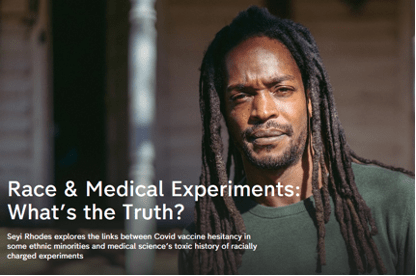The Need for Clinical Trial Diversity: How We Got Here and Where We're Headed
Article
Patient Engagement & Recruitment


Health equity has become a common catchphrase in today’s society, but perhaps its most accurate definition comes from Ricki Fairley, CEO of Touch, The Black Breast Cancer Alliance. In a webinar titled “Disparities in Clinical Trials,” Fairley stated simply that health equity is “when a doctor treats a patient like they’re family.”
New phrases are being coined right and left to address this issue. In an interview withMedPage Today, Utibe Essien, MD, MPH, of the University of Pittsburgh used the term “pharmacoequity.” And at the ViVE Conference, the HLTH Foundation and College of Healthcare Information Management Executives (CHIME) cosponsored a “techquity” track, exploring technology as a tool for achieving health equity.
Regardless of semantics, an important goal of health equity is to increase awareness of and access to medical treatments. Clinical trial diversity, the inclusion of underrepresented segments of the population in medical research, goes hand in hand with that goal. In the wake of the coronavirus pandemic, the public has become increasingly aware of the need for clinical trial diversity.
Census figures from 2021 show that ethnic and racial minorities comprise over 40% of the U.S. population; however, in the Federal Drug Administration’s (FDA) 2022 data snapshot, whites comprised the majority of patients enrolled in clinical trials.
Health literacy—or lack thereof—can pose a major challenge in the pursuit of clinical trial diversity. As we saw with COVID-19 vaccines, those with low health literacy have difficulty distinguishing misinformation from facts and are likely to be swayed by conspiracy theories. A survey by GoodRx revealed that while over 70% of respondents had been exposed to medical or health-related misinformation, of those, nearly half were not confident in their ability to discern the truth.
The Health Resources & Services Administration defines health literacy as “the degree to which individuals have the capacity to obtain, process, and understand basic health information needed to make appropriate health decisions.” This is easier said than done, especially when it comes to clinical trials, with medicalese that can stump even industry professionals and a legacy of mistrust harbored by many underserved groups.
Today’s mistrust of the medical establishment and pharmaceutical industry among certain groups, prime among them Black patients, did not happen overnight. In his documentary “Race & Medical Experiments: What's the Truth?” Seyi Rhodes details a toxic history of racially charged experiments contributing to a mistrust of medical science.

Reading from the autobiography of physician J. Marion Sims, known as the “father of modern gynecology,” Rhodes relates how slaveowners brought Black women slaves to Sims’ makeshift hospital, where the doctor performed experimental operations on them as early as 1845 — without anesthesia.
In a webinar sponsored by Montgomery County (PA) Community College on “Understanding Medical Racism” Dr. Maranda C. Ward, Assistant Professor of Clinical Research and Leadership at George Washington University’s School of Medicine and Health Sciences, provided a laundry list of medical racism in the U.S. In 1882, Dr. Ward said, graverobbers went to Black cemeteries to exhume cadavers used in medical schools.
Of course, in his documentary Rhodes mentions the infamous 1932 Tuskegee experiment, billed as a study of “bad blood,” by the U.S. Health Department. The real purpose was to track the full progression of syphilis among Black men, and the study provided no treatment. Over the 40-year-long study, 128 participants died, about 40 wives were diagnosed, and 19 babies contracted syphilis at birth.
And Rhodes would be remiss if he had omitted the story of Henrietta Lacks, a Black woman undergoing treatment for cervical cancer in 1951 at Johns Hopkins Hospital. A sample of her cancer cells, nicknamed “HeLa,” was taken without her consent. Her family did not learn of this until 1975.
The documentary also highlights disparities in maternal and infant health in the Black community. Rhodes interviews Dr. Stephen B. Thomas of the University of Maryland, a leading scholar in the effort to eliminate racial and ethnic health disparities. “A Black woman with a college degree is more likely to have her baby die in the first year of life than a white woman who hasn’t even graduated from high school. Why is that?” asks Dr. Thomas. “Racism. Institutional racism. Structural inequality.”
“Unequal Treatment,” released in 2002, was the first major report to point to longstanding systemic racism — not poverty, lack of access to health care, or other social factors — as a major reason for the nation’s deeply entrenched health disparities.
Ironically, it is those most reluctant to participate in clinical trials — BIPOC individuals — who are most needed to test new treatments. Many minorities are predisposed to certain conditions, putting them at higher risk. Black individuals in particular often have different reactions to drugs, which sometimes can be adverse or even fatal, compared to white participants.
Encouraging minority participation in medical research starts with the study team. People of color are more likely to trust clinical studies run by people that look like them. Women of Color in Pharma (WOCIP), has created a think tank and playbook as strategic resources to help pharmaceutical and life sciences companies on diversity and inclusion efforts.

One way to connect with underrepresented groups is meet them where they are, in their communities. As seen during the coronavirus pandemic, Black-owned barbershops joined in the effort to encourage patrons to get the COVID-19 vaccine. Another program, Live Chair Health, is “working to close the life expectancy gap of African Americans one barbershop at a time.”
Another way to meet people where they are is through decentralized clinical trials (DCTs). Because socioeconomic conditions such as inability to take time off work may present barriers to clinical trial participation, bringing studies to the participants can help course correct.
On top of these overarching health disparities, some individuals trying to tackle the issue are facing harassment. Dr. Aletha Maybank joined the American Medical Association (AMA) as its first chief health equity officer and has since received at least one death threat.
An extremist group protested outside Boston’s Brigham and Women’s Hospital. The protesters passed out fliers naming two doctors who designed a pilot program aimed at improving cardiology outcomes for Black and Latino patients.

Both professional and grassroots efforts are underway to raise awareness and bridge the diversity gap in clinical trials. Here are a few examples of grassroots initiatives:
Below are a few inroads being made within the pharmaceutical industry itself:
And following is a hybrid example, combining both grassroots and clinical expertise:
In order to increase representation of underserved populations in clinical trials, a siloed approach will not work. Professionals, advocacy groups, and community organizations must come together to build trust, starting with education. The work, however, doesn’t stop there. Patients must also be heard and engaged before recruitment, enrollment, and retention can be effectively addressed.
| Bill Name/Number | Key Provisions on Promoting Diversity |
| Diverse and Equitable Participation in Clinical Trials (DEPICT) Act (H.R. 6584) | Directs the FDA to issue regulations requiring sponsors to develop a diversity plan for clinical trials, including: estimated prevalence of a condition or disease by demographic subgroups; targets for enrollment by age, sex, race and ethnicity; rationale for enrollment targets; and an action plan for how the targets will be met. Sponsors must file an annual report on progress in meeting the enrollment targets and any updates that need to be made to the diversity action plan. The FDA may mandate postapproval studies or postmarketing surveillance due to insufficient demographic group data, although the agency also can waive these studies. Directs the FDA to gather stakeholder input on clinical trial flexibilities instituted during the COVID-19 pandemic and recommendations for incorporating certain trial disruption mitigation strategies into current or new guidance to improve clinical trial access and enrollment of diverse populations. Requires the FDA to issue an annual report on progress in increasing diversity in clinical trial and study enrollment. |
| Diversifying Investigations Via Equitable Research Studies For Everyone (DIVERSE) Trials Act (H.R. 5030) | Requires the FDA to issue draft guidance on conducting decentralized clinical
trials with meaningful demographic diversity, including racial, ethnic, age,
gender, and geographic diversity in patient engagement, enrollment, and
participation. Guidance should address how to appropriately use digital health
technologies or other remote assessment options such as telemedicine. Provides a safe harbor for free provision of digital health technologies by drug or device manufacturers to clinical trial participants. Provides a safe harbor for remuneration to clinical trial participants that facilitates equitable inclusion of patients from all relevant demographic and socioeconomic populations and is related to trial participation. |
| Equity in Neuroscience and Alzheimer’s Clinical Trials (ENACT) Act (H.R. 3085) | Directs the National Institutes of Health to provide incentives and outreach to increase diversity in Alzheimer’s disease research through cooperative agreements, grants, training awards and establishment of clinical trial sites in areas of high minority concentration. |
| Cures 2.0 Act (H.R. 6000) | Requires a Government Accountability Office report reviewing how the
Department of Health and Human Services addresses barriers to clinical trial
participation from under-represented populations and recommendations to
address such barriers. Requires HHS to formulate a public awareness campaign to increase awareness and understanding, particularly in minority communities, about clinical trials. Requires convening a permanent task force to make ClinicalTrials.gov more user-friendly. |


